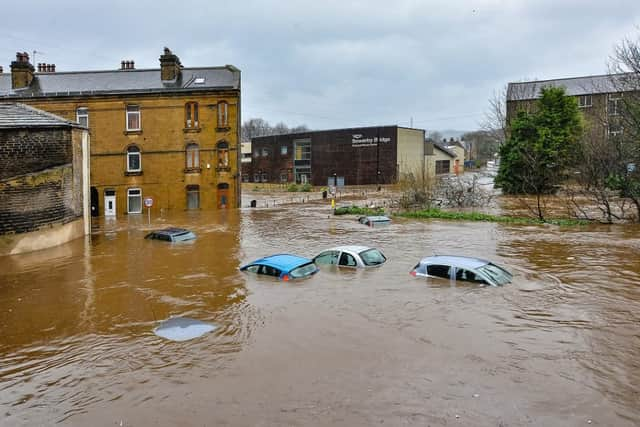Dress up for festive season - go retro or second-hand clothes


Going Green by green campaigner and consumer expert, Angela Terry, who separates climate change facts from fiction and explains how you can take simple, practical steps to help save the planet. Follow @ouronehome for more advice.
Q: I want to dress up for festive celebrations, but how can I look fabulous without hurting the planet?
Advertisement
Hide AdAdvertisement
Hide AdA: There are lots of eco-friendly ways to dress up without buying anything new. It’s all about being creative.
For a start, did you know that clothes hire is booming? It’s a great way to save wardrobe space and money.Even Marks & Spencer is getting in on the act.
The high street retailer recently paired up with fashion rental website Hirestreet to offer womenswear pieces from its Autograph range.
Other sites worth checking out are Girl Meets Dress and My Wardrobe HQ.
Alternatively, you can buy vintage or second-hand.
Advertisement
Hide AdAdvertisement
Hide AdConsidering A-listers like Kim Kardashian, Jennifer Aniston and Gwyneth Paltrow have all worn vintage for special occasions, it’s definitely glam.


But you don’t have to splurge a fortune on retro designer gear in specialist boutiques.
Have you considered the idea that older relatives may be the source of fantastic vintage finds?
After all, Princess Beatrice wore her gran’s 1960’s dress for her 2020 wedding (of course, it helps that her gran’s the Queen!)
Advertisement
Hide AdAdvertisement
Hide AdIf there are no 1950’s cocktail dresses lurking in your auntie’s closet, websites like Oxfam have an incredible range of nearly new outfits, which you can search by size, designer and colour.
Alternatively, you could upcycle an old garment.
The website Love Your Clothes has lots of ideas.
Or you could get into what’s known as ‘swishing’ and organise clothes swapping events with friends.
Make sure to serve fizz!
If you’re not the same size, you can focus on accessories.
Handbags, scarves, belts and jewellery can instantly lift an outfit.
You can even rent a designer handbag from Selfridges or Hurr.
Advertisement
Hide AdAdvertisement
Hide AdIf you are still tempted to pick up a high street outfit, try to buy good quality clothes that will last.
Fashion is one of the most polluting industries out there.
It creates up to ten per cent of all global greenhouse gas emissions.
That’s significantly more than all aviation and shipping emissions combined. If we don’t ditch fast fashion, the
United Nations estimates it will take up a quarter of the world’s carbon budget by 2050.
Advertisement
Hide AdAdvertisement
Hide AdBrits are the biggest fast fashion addicts in Europe. Every year, we send 300,000 tonnes of clothing to landfill.
Much of it is made from nylon or polyester, which, like plastics, are produced from oil.
These fabrics can take 200 years to decompose leaving dangerous microplastics in the soil and oceans.
Hopefully, the time’s come for us to reconsider our attitudes to shopping and embrace green style that lasts.
Celebrity spot
Advertisement
Hide AdAdvertisement
Hide AdFloodwaters don’t care who you are.Located on an island in the Thames, the £12 million mansion of Hollywood actor George Clooney is at risk of flooding.


The Oscar winner, 60, moved into the Grade-II-listed property with his barrister wife Amal in 2016.
Its grounds flooded that same year and also in 2020, when their tennis court, summer veranda and much of their lawn were left underwater. As a result, they’ve invested in property flood equipment to protect their home.
Green swap
Swap your Christmas crackers for reusable ones.


In the UK, around 40 million crackers get binned. As most contain single-use plastic, it represents an incredible amount of pollution.
Advertisement
Hide AdAdvertisement
Hide AdYou can buy reusable crackers from websites like Keep This Cracker.
How to work out if you're at risk of flooding


With Storm Arwen and then to follow that Storm Barra hitting the UK, we are already experiencing the rise in extreme weather events that come with global warming.
And it’s not just us.
All over the world – from Spain to Hawaii – heavy rainfall and flooding are on the increase.
Indeed, a study by the World Meteorological Organization says that two thirds of the world’s land will experience wetter, more variable conditions as things heat up.
Here in the UK, one in five homes could flood.
Advertisement
Hide AdAdvertisement
Hide AdThat’s a terrible situation – made even worse by the fact that too many affected people aren’t even aware of their own predicament.
How do you know if your home or business is at risk?
Changing rainfall
It’s not only people living by the coast, rivers or reservoirs who need to consider this issue.Surface water and groundwater flooding are becoming more common.
With each rise in temperature of one degree, the atmosphere holds seven per cent more moisture – meaning
rains are more torrential.
Drainage systems can’t cope with such intense downpours and the underground water table rises and soils are saturated.
This is when flash floods occur.
Check
Advertisement
Hide AdAdvertisement
Hide AdThe first thing you can do is check your local flooding risk.
You can visit https://www.gov.uk/check-long-term-flood-risk.
This site lets you check every English postcode and also provides links to flood risks in Northern Ireland, Scotland and Wales – these figures provided respectively by the Northern Irish Executive, the Scottish Environmental Protection Agency and Natural Resources Wales.
Act
If you are at risk the most important thing to do is act.
A flood may seem highly unlikely if there is no memory of your community flooding, but these are unprecedented times. Forewarned is forearmed.
Advertisement
Hide AdAdvertisement
Hide AdHere are three things to do straight away: sign up for free flood alerts, check your contents insurance covers flooding and make a plan for if the worst should happen, in terms of where you, your loved ones and pets could stay.
New homes
Finally, if you’re buying a new home, be really careful to look into the flood risks.
It seems unbelievable but planning applications have been granted for more than 5,000 new homes to be built in flood risk areas in England alone this year.
You don’t want to invest your hard-earned cash into a home that is destined to end up underwater.
Fact or fiction
Washing up by hand is greener than a dishwasher.
Advertisement
Hide AdAdvertisement
Hide AdThis is false! Dishwashers are increasingly energy and water efficient, so ditch the rubber gloves and let the machine do the work.
Just make sure you fill it properly first.